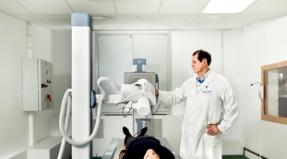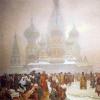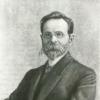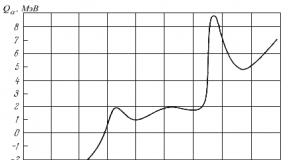Science cities of the Russian Federation. Science cities of Russia: the country's intellectual potential
A science city in Russia is a municipal entity with the status of an urban district, or a district of a larger city that has high scientific and technical potential, with a city-forming scientific and production complex.
The term science city was introduced for the first time in the city of Zhukovsky, Moscow region, by Spartak Petrovich Nikanorov and Natalya Konstantinovna Nikitina in 1991 when creating the Union for the Development of Science Towns movement.
The movement proactively developed a draft Concept of State Policy for the Preservation and Development of Science Cities.
The first versions of the draft law “On the status of a science city of the Russian Federation”* were developed in 1995. One is in the Federation Council, the other is in the State Duma.
Obninsk became the first Russian science city in 2000, where developments in the field of peaceful atom were and are being carried out.
By 2004, seven science cities had already received the official status of “Science City of the Russian Federation” (Obninsk, Korolev, Dubna, Koltsovo, Michurinsk, Reutov, Fryazino), six more had passed all examinations and approvals at the federal level (Biysk, Zhukovsky, Petergof, Pushchino, Seversk , Troitsk).
As of January 5, 2015, thirteen city districts already have the status of a science city, assigned in accordance with federal law: Biysk ( Altai region), Dubna (Moscow region), Zhukovsky (Moscow region), Koltsovo (Novosibirsk region), Korolev (Moscow region), Michurinsk (Tambov region), Obninsk (Kaluga region), Protvino (Moscow region), Pushchino (Moscow region), Reutov (Moscow region), Troitsk (Moscow), Fryazino (Moscow region), Chernogolovka (Moscow region).
Main specialization of science cities
There are seven main specializations of Russian science cities:
- aviation, rocketry and space research;
- electronics and radio engineering;
- automation, mechanical and instrument engineering;
- chemistry, chemical physics and creation of new materials;
- nuclear complex;
- energy;
- biology and biotechnology.
Currently, the number of unofficial science cities in Russia includes 65 urban and rural settlements, located mainly in the main settlement zone of the country. About half of them are located in the Moscow region (namely, 29, including the city of Zelenograd, which is administratively part of the city of Moscow, but located on the territory of the region).
Outside the capital region in Central Russia there are 8 more similar territorial entities in the Vladimir, Kaluga, Nizhny Novgorod, Tver and Yaroslavl regions.
Moscow is considered the first and most recognized scientific center, but the Moscow region is no less large, and according to some indicators (experimental, testing base, etc.) a more significant scientific and scientific-industrial complex.
The second region of the country in terms of concentration of science cities is the Urals. Most of them are concentrated in the Sverdlovsk and Chelyabinsk regions. In third place is Western Siberia, in the southern part of which there are 6 science cities - in the Altai Territory, Novosibirsk and Tomsk regions.
Director of the Union for the Development of Science Cities Mikhail Kuznetsov
According to Mikhail Kuznetsov, director of the Union for the Development of Science Cities of Russia:
“It is now almost obvious that innovative development is essentially the only opportunity for Russia to take its rightful place in the global economic space of the 21st century and maintain (or restore) the status of a Great Power. Exploited and exported natural resources (primarily oil and gas) and their primary processing products fundamentally cannot be the basis for this; moreover, they make Russia dependent on the developed countries of the world.
It is necessary to move from the fuel and raw material orientation of the economy to its innovative development, stimulating the use of the results of scientific research and intellectual activity in energy, transport, mechanical engineering, instrument making, aerospace, and other knowledge-intensive industries, as well as in education, medicine, information and biotechnology . To do this, it is necessary to activate and stimulate powerful intellectual, scientific and technical potential, which is currently in demand to a very small extent, primarily due to the unprecedented drop in production that occurred in the nineties, especially in knowledge-intensive sectors of industry.”
Assessments of Russian intellectual, scientific and technical potential as outdated, cumbersome, superfluous, which took place in some analytical and senior management circles in Russia in these years, do not stand up to criticism. Use of “leakage” abroad in various ways Russian developments in combination with the “brain drain” from Russia and the “hunt” of foreign companies for Russian young scientists, graduate students and even students, speaks precisely of its high level and relevance.”
From the history of science cities
Russian scientific and technical potential was distributed very unevenly territorially. Just ten years ago, approximately 70% of all scientific research was carried out in research centers, universities and laboratories located in Moscow and the Moscow region, St. Petersburg, the Novosibirsk region and the Urals.
Most science cities were created in the 30s, 50s and 70s by special regulations higher authorities the country's authorities to solve the most important state tasks: the general strategic and political goals of the leadership of the USSR required the development of the military-industrial complex and its scientific and technical support. Implementation largest projects- first aviation, then atomic (nuclear), rocket and space, and later biological - led to the creation of corresponding scientific and technical complexes with corresponding settlements.
Until recently, many of them were not shown on maps, were not mentioned in reference books and had special code, often “numbered” names.
In the list of science cities accompanying the map showing their location on Russian territory, some of these former names are indicated in parentheses. These are cities such as Sarov, Snezhinsk, Seversk, Zheleznogorsk, Ozersk and others. These cities are still relatively open today. They began to talk and write more about them, but they have a special status established by law as Closed Administrative Territorial Entities (CATE) with a number of restrictions.
 Zheleznogorsk (Krasnoyarsk-26, Sotsgorod, Atomgrad), Krasnoyarsk Territory, photo: Sergey Filinin
Zheleznogorsk (Krasnoyarsk-26, Sotsgorod, Atomgrad), Krasnoyarsk Territory, photo: Sergey Filinin In other cities, “closedness” was manifested in a ban on visits by foreign citizens and the absence of references to a number of city-forming enterprises and organizations in the open press. Such science cities include Obninsk, Troitsk, Protvino, Zhukovsky, Khimki, Korolev, Dzerzhinsky, Sosnovy Bor and many others.
Today's science cities are very different in scale, nature, and types of activities.
Based on the nature and profile of scientific complexes, science cities are divided into:
> monoprofile
> mono-oriented
> complex
A typical example of a single-industry science city is Obolensk, which socially and infrastructurally provides one State scientific center - the Scientific Research Institute of Applied Microbiology. This type includes Beloozersky, Koltsovo, Krasnoznamensk, Mendeleevo, Protvino, Snezhinsk and others.
 Vaccine production at the Microgen plant, Obolensk
Vaccine production at the Microgen plant, Obolensk Mono-oriented science cities have several city-forming enterprises in the same sphere of scientific and technical activity. This is, for example, Zhukovsky, where the largest research, testing and production complexes for aviation are located. Science Center Russian Academy Sciences in Chernogolovka, created in 1959. Currently, there are 7 research institutes and 2 research and production enterprises operating in Chernogolovka. The main areas of research are chemical physics. Zelenograd, Krasnoobsk, Pushchino, Trekhgorny, Yubileiny are also mono-oriented.
 International Aerospace Salon MAKS-2015 in Zhukovsky
International Aerospace Salon MAKS-2015 in Zhukovsky The most typical example of a comprehensive science city is Dubna, where, in addition to the Joint Institute for Nuclear Research, there are scientific, design and scientific-production centers for aerospace, instrument-making, shipbuilding, and an international university.
Klimovsk, Kovrov, Komsomolsk-on-Amur, Korolev, Obninsk, Reutov belong to the same type. Complex science cities also include a number of academic towns of research centers of the Russian Academy of Sciences, which include scientific organizations of various profiles.
At the same time, a number of unofficial science cities are original testing grounds and experimental testing complexes, or are primarily such, having other enterprises and organizations on their territory. These are, for example, cities and towns such as Autopolygon (Dmitrov-7), Beloozersky, Znamensk, Krasnoarmeysk, Mirny, Novostroika, Raduzhny, Remmash and others.
Science cities of the future
On September 28, 2010, Dmitry Medvedev signed the Federal Law “On the Skolkovo Innovation Center”.

Skolkovo (Moscow region)- the first scientific and technological innovation center in Russia in post-Soviet times to be built from scratch for the development and commercialization of new technologies. The project is conceived as one of the key elements of Russian modernization, designed to end the resource-based orientation of the economy and transfer it to an innovative path of development, and provides for the creation of a favorable environment for the concentration of Russian and international intellectual capital capable of independently generating innovations.
> cluster of biomedical technologies;
> cluster of information and computer technologies;
> cluster of space technologies and telecommunications;
> cluster of energy efficient technologies;
> nuclear technology cluster.
A technology park will also operate within Skolkovo. Its strategic goal is to provide innovative companies participating in the project with all the necessary support for the successful development of their technological assets and corporate structures. The technopark plans to implement this task by attracting the infrastructure and resources available to the Skolkovo project and its partners.
In addition, in Tatarstan, on the right bank of the Volga River, since 2012, the second innovative science city Innopolis, an analogue-partner of Skolkovo near Moscow and a satellite city of Kazan, is being built in Russia, designed for 155 thousand residents.
 Innopolis, Tatarstan - what the city will look like
Innopolis, Tatarstan - what the city will look like Nowadays, a number of objective (issues of taxation, land ownership and land use) and subjective reasons (extremely slow review of documents in the bureaucratic structures of federal ministries and departments) in many cases aggravate relations between various actors in science cities, generate disbelief in the ability of the government to implement the stated priorities, to make them systemic management, development and use of their innovative potential in science cities.
It is necessary to provide not so much funding for the urban infrastructure of science cities, but to stimulate innovative activity on their territory. The experience of Dubna, Obninsk, Koltsovo and other science cities shows that small state funding of innovative projects with competent policies allows one to attract many times larger resources from non-state sources.”
M.I. Kuznetsov
Found a mistake? Select it and press left Ctrl+Enter.
It is now almost obvious that innovative development is, in fact, the only opportunity for Russia to take its rightful place in the global economic space of the 21st century and maintain (or restore) the status of a Great Power. Exploited and exported natural resources (primarily oil and gas) and their primary processing products fundamentally cannot be the basis for this; moreover, they make Russia dependent on the developed countries of the world. It is necessary to move from the fuel and raw material orientation of the economy to its innovative development, stimulating the use of the results of scientific research and intellectual activity in energy, transport, mechanical and instrument engineering, aerospace, and other knowledge-intensive industries, as well as in education, medicine, information and biotechnology. To do this, it is necessary to activate and stimulate powerful intellectual, scientific and technical potential, which is currently in demand to a very small extent, primarily due to the unprecedented drop in production that occurred in the 1990s, especially in knowledge-intensive sectors of industry.
Assessments of Russian intellectual, scientific and technical potential as outdated, cumbersome, superfluous, which took place in some analytical and senior management circles in Russia in these years, do not stand up to criticism. The use abroad of Russian developments “leaking” in various ways in combination with the “brain drain” from Russia and the “hunt” of foreign companies for Russian young scientists, graduate students and even students speaks precisely of its high level and relevance.
The difference between the concepts of “science city” and “technopark”
A science city is, firstly, a city, a natural formation, not an artificial one. Secondly, this is a full cycle from a scientific idea (not necessarily a project) to a product. Thirdly, it is a center for education and training. Fourthly, this is a place of residence, and not just a place of “application” of knowledge.
Construction models:
- Science cities should define themselves not as closed administrative territorial entities surrounded by a fence, but as functional territorial-industrial research and production sites, permeated with a network of modern information, transport, and energy communications.
- The model of a modern science city is a full cycle of production of high-tech products. This is the path from a scientific idea to a competitive product. This is a platform that organizationally combines scientific, design and production activities.
- Science City is a center for the generation, accumulation, and transfer of knowledge.
- Science cities should not be objects, but cities that have the full range of opportunities for a full-fledged human life.
Approaching the technology park. An industrial giant, for example, an automobile company, which has its own research institutes, has no time and, perhaps, no interest in following what is constantly being born in the heads of professors, graduate students, and students. Therefore, the need arose to create some intermediate links, where the emerging idea would be embodied in something material. Not immediately into a new plane or a completely new car, but into some part of the plane or into a software product that will already be of interest to a large corporation. The university is interested in the idea as an idea, but it does not have the money to bring the idea to a specific product. Yes, and there is no desire. A scientist is structured differently than a businessman. In short, the ideology of technology parks is as follows: the state does not give money for specific developments, it provides certain preferences to private businesses, which should give money for their own development. Business is ready to finance the idea, but is reluctant to invest in infrastructure.
Approaching complex science. But the university is characterized, first of all, by universality, universal coverage of all scientific disciplines and areas. This is the first feature of the university technology park. Second: within an educational institution there are potential personnel of different profiles, and their training and “distribution” can be carried out. Third: the university has a high human resources potential, so the level of its developments is quite high. And finally, the fourth feature: professional cooperation within the university is very possible and desirable, cooperation between different laboratories, departments, institutes and faculties working on similar topics. This gives a significant additional effect. For example, physicists, chemists, and mathematicians of various specialties work in the field of nanotechnology.
From the history of science cities
The cities of science themselves – the idea of their creation – appeared before the Second World War in Germany. This was the city of Peenemünde, where “weapons of retaliation” were created - rockets "Fau".
This began to develop especially rapidly after the war, when it was necessary to create and nuclear weapon, and rocketry as a means of delivery, and aviation, and electronics. Soviet Union set an example for everyone here. There were very few resources: the post-war impoverished country collected resources bit by bit. These installations appeared, qualified people appeared, and everything called high-quality infrastructure began to grow around them. Settlements appeared with a concentration of talented people, rare in world experience, which gave phenomenal results.
- The Union for the Development of Science Cities of Russia was created.
- A document was prepared (and supported) entitled “Fundamentals of State Policy. Preservation and development of science cities.”
- Hearings were held on the issue of science cities. The preparation of materials and proposals on state policy regarding science cities was underway. A draft Presidential Decree “On measures for the preservation and development of science cities” has been prepared. By mid-1993, the project was sent to the President.
- The draft law “On the status of the science city of the Russian Federation” was born...
- It passed the first reading in the State Duma, but got bogged down in lengthy approvals.
- President B. Yeltsin signed the Decree “On measures for the development of science cities as cities of science and high technology».
- The State Duma adopted the Law “On the status of the science city of the Russian Federation.”
- The law on the status of a science city was approved by the Federation Council. President Boris Yeltsin vetoed the law. Thanks to the intensive work of the “science city” people, the veto was eventually overcome, and the Law “On the Status of the Science City of the Russian Federation” finally came into force.
- The status of “science city of the Russian Federation” was assigned to the city of Obninsk, Kaluga region. Preparation of other projects.
- The city of Korolev, Moscow Region, receives the official status of “science city of the Russian Federation.”
Classification of science cities
Based on the nature and profile of scientific complexes, science cities are divided into monoprofile, mono-oriented And complex.
- An example of a single-industry science city is Obolensk, which socially and infrastructurally provides one state scientific center - the Research Institute of Applied Microbiology. Protvino with the State Scientific Center IHEP can be attributed to the same type, although here in last years enterprises of various profiles appear.
- Mono-oriented science cities have several city-forming enterprises in the same field of scientific and technical activity. This is, for example, Zhukovsky, which houses the largest aviation research and testing complexes; Chernogolovka is a scientific center of the Russian Academy of Sciences with research institutes and laboratories in the field of chemical physics.
- The most typical example of a comprehensive science city is Dubna, where, in addition to the Joint Institute for Nuclear Research, there are scientific, design and research and production centers for aerospace, instrument making, shipbuilding, and an international university.
Science cities in the Moscow region have a very wide range of specializations in both fundamental and applied science:
- rocket and space technologies – Korolev, Khimki, Balashikha;
- Center for Aviation Science – Zhukovsky;
- fundamental research is mainly concentrated in Dubna, Protvina, Pushchino, Troitsk, Chernogolovka;
- testing and metrological complexes - in Beloozersky, Zhukovsky, Krasnoarmeysk;
- centers of radio engineering and electronics - in Zelenograd and Fryazin;
- centers dual technologies– in Dzerzhinsky, Klimovsk;
- microbiology and biotechnology - in Pushchin and Obolensk.
The value of the “science city” status
The main source of funding for the science city will not be budgetary. Budget money is needed only as start-up capital; this is no more than one tenth of all financial investments. The main funding for developments will come from attracting investors who will benefit from investing in the implementation of scientific developments. The status of a science city opens up broad development prospects for the university complex due to the deduction of interest from the implementation and sale of developments. And the developed and developing infrastructure of the technology park, the presence of a specialized scientific and technical community will additionally attract new investors.
Weak explanatory work about the goals and benefits of this project. So weak that even Professor N. N. Krasikov (from the city of Kovrov - see below) has no idea what he is talking about. Science cities are not allocated money to repair roads or provide public utilities. But enterprises in science cities have advantages when distributing government orders for the development or production of high-tech products. Science cities retain enormous potential, created during the Soviet period on orders from the military-industrial complex. Enterprises in science cities have advantages when entering global markets for competitive products. Enterprises in science cities have real tax benefits, and governing bodies of science cities have advantages when forming budgets at different levels. This is the only reason why science cities have the opportunity to develop production that is valuable to the country, as well as support the social and communal sphere.
Successful examples of science cities and their difficulties
Innovation brings constant growth to the entire economy. The USA has more than 90% of the increase in its gross product only due to the innovative economy. But we have crumbs in the full sense of the word: who says 6%, who says half a percent - it’s impossible to count.
Today, a tomograph is being developed in Obninsk, without which medicine cannot practice today. effective treatment, and this tomograph will be ten times cheaper than what is sold on the market - this is a solution to people’s health problems, and not just a new development that has appeared.
In 2003, Dubna, having received approximately 115 million rubles budget money, attracted about 500 million non-state. And the result: for the first time, a non-state, private accelerator was built for the production of membranes for the extremely effective medical process of plasmaphoresis.
Obninsk as of 2004. During the period of operation of the program (science city), a significant economic effect was obtained. From 1999 to 2003, tax revenues increased fourfold: from 316 million rubles. up to 1291 million rubles. Average wage in the city increased from 1440 rubles. per month up to 4501 rub. Another important result of the program is the creation of the Obninsk technological park and municipal industrial zone. Of the 22 announced investment projects, eight were selected for placement in it. This year, investors are starting to build their enterprises. The total volume of attracted investments is about 60 million dollars. It is expected that tax revenues will increase by 60-80 million rubles. The project for the further development of Obninsk as a science city was supported. According to the governor, special attention at the next stage of the program must be paid to achieving results on a federal scale - Obninsk should become the center for the development of the national innovation system.
Many have been going around in circles for three years now, from government to government. Nothing in the programs changes except dates. Sometimes they ask to change the plate in order to present the indicators differently. We ask why cities that are ready for this development cannot be skipped? There is experience, there are results. They answer: there is no money in the budget. They planned 300 million rubles, but no more. Therefore, you can no longer give status to anyone. Well, increase the amount, God knows how much money is invested, and the effect is almost instantaneous: the city budget increases significantly. No, they say, money is given only for the actual number of science cities. There are no new cities with status, we cannot increase the amount... This circle of bureaucrats is simply another national crime. And why is also clear. Who sits in the government? Those who were sent by the raw material oligarchs. Now they have bought Volsky’s RUIE, they go to the President, give their proposals, which are sent down to the government as an order from the President. And there the people sent by these raw material producers implement a similar policy.
So, despite this, as well as the statements of the President, the decisions he signed State Council, the Security Council, the declaration in the President's Address to the Federal Assembly of the Russian Federation, in which he proclaimed and repeatedly confirmed the course for the innovative development of the country, the Government prepared and defended with manic tenacity a bill (the notorious bill on “monetization of benefits”), in which Article 124 proposed to introduce significant changes to the law “On the status of the science city of the Russian Federation”.
We are talking, first of all, about the abolition of development programs for science cities, that is, about the rejection of the basic principles of state policy regarding science cities:
- program principle, providing for the specification of projects planned for implementation, establishing the mutual responsibility of the municipality and the state, guaranteeing transparency in the execution of budgets of science cities in terms of financing innovative projects and the creation (development) of infrastructure;
- principle of concentration and the use of funds from all sources - federal, regional and local budgets, extra-budgetary funds for the implementation of science cities development programs.
Completely unfounded, a significant tightening of the criteria for assigning the status of a science city of the Russian Federation to municipalities was proposed (the cost of fixed assets of the research and production complex should be at least 50% of the cost of all fixed assets, and the volume of scientific and technical products of the complex in value terms should be at least 50% the total volume of production of all economic entities on the territory of a given municipality, as well as the number of employees in organizations of the scientific and production complex must be at least 15% of the number of all employees).
And, apparently, just to clarify who is in charge of innovation, it is proposed to assign the status by decision of the Government, and not by decree of the President.
Unfortunately, despite the efforts made, dozens of amendments prepared by the Union for the Development of Science Cities of Russia and introduced by deputies of the State Duma and members of the Federation Council, including the chairmen of the relevant committees of both chambers of the Federal Assembly, “conciliation meetings” held with representatives of the Ministry of Finance (authorized representative of the Government), despite appeals (including those supported by the governors of the Moscow, Novosibirsk, Tambov regions) to the leaders of the State Duma, to the ministries, etc., etc., it was possible to defend only the criteria (and then only partially: 50 % of the value of funds or 50% of the volume of production, subject to 15% of the number of employees).
The modern “science city” situation
The other day (10/14/2005), chaired by the Minister of Education and Science of Russia Andrei Fursenko, at a meeting of the Interdepartmental Commission on Scientific and Innovation Policy of the Russian Federation (IMC), a decision was made to assign the status of a science city to Troitsk and Zhukovsky near Moscow, as well as Dimitrovgrad. A fourth candidate was also considered, but it was rejected - the documents of the city of Kovrov were sent for revision.
“At the same time, assigning the status of a science city of the Russian Federation is not a simple procedure. The decision of the International Commission for Internal Affairs means that a significant path has been passed, but it is still necessary to obtain the opinions of the interested ministries and departments, and only after that can we expect a government resolution,” notes Mr. Shalmanov. To date, only 8 municipalities on the territory of the Russian Federation have the official status of a science city of the Russian Federation: Obninsk (Kaluga region, May 2000), Dubna, Korolev (Moscow region, late 2000), Koltsovo (Novosibirsk region, February 2003), Reutov, Fryazino (Moscow region). region), Michurinsk (Tambov region, December 2003), Peterhof (July 2005). And now, after the positive decision of the International Commission for Internal Affairs, five cities are awaiting assignment of the status: Biysk, Pushchino, Troitsk, Zhukovsky and Dimitrovgrad. No other applicants are expected in 2005, since the remaining cities that previously nominated their candidacies need to prepare their documents anew. Apparently, all of them will be considered only next year.
Prospects for the Vladimir region: the cities of Kovrov and Raduzhny
Kovrov
The Economic Policy Committee recommended the request of the Kovrov city administration for consideration by the Legislative Assembly of the Vladimir Region. It concerns the assignment of the status of a science city to the city. The final decision must be made by the Russian Government.
According to Anatoly Bobkov, deputy chairman of the Economic Policy Committee of the Legislative Assembly, this is the first case in the region. There were such plans for Raduzhny, but the package of documents has not yet been prepared. The leadership of the Vladimir region and the city of Kovrov will make every effort to ensure that the first science city appears in the region.
At the committee, deputies voted unanimously. They believe that Kovrov has every chance of receiving the status of a science city. Almost 100 years ago it became a city of gunsmiths, where the main city-forming enterprises are defense ones. It has a powerful scientific base and the ability to train personnel, including highly qualified ones. Kovrov deserves to become a platform on which experimental high-tech production will be tested.
Infrastructure– a city research and production complex of 10 well-known enterprises and scientific organizations in Russia and abroad, in particular:
- JSC "Plant named after. V. A. Degtyareva" (ZiD)
- OJSC "Kovrov Electro-Mechanical Plant" (KEMZ)
- OJSC Kovrov Mechanical Plant (KMZ)
- Special design bureau for instrumentation and automation
- FSUE VNII "Signal"
- Branch of the Federal State Unitary Enterprise "State Space Research and Production Center named after. M.V. Khrunichev"
- Kovrov State Technological Academy (KSTA)
Event: filing an application for science city status in 2005 - documents are sent for revision.
Doubts: many are not sure that the city is ready for this (hints of profanity, support from the authorities - in Obninsk there were initially problems with the local authorities). For example, Kovrov’s internal strife can be observed on Internet forums:
All enterprises and institutions of the city whose activities have a scientific component are involved in the preparation of documents for assigning the status of “science city” to Kovrov. Until now, such large-scale work on generalization and inventory of intellectual resources has not been carried out in the city. Regardless of whether Kovrov receives or does not receive the status of “science city,” the work done is already useful, since it unites the efforts of representatives of different teams to solve a citywide problem. The contribution of Professor N. N. Krasikov to a common and useful cause for the city is little noticeable. But there is an Elephant, and you can bark at it.
Polyanin V. A., Vice-Rector for Academic Affairs of KSTA, Ph.D., Associate Professor.
Oh, Moska, you know she’s strong!..(Response to Professor N. N. Krasikov)
Another thing is that Krasikov absolutely rightly does not believe in the possibility of creating in our city, at least in the coming years, any large research and production center and speaks about this honestly and openly. You, Mr. Polyanin, judging by your “pathos” and “angry sarcasm,” continue to believe in the Kovrov-Naukograd project. So go for it! These same federal ministers, as far as we know, recognized the “academy” in which you work as one of the worst universities in the country, placing KSTA in the ranking of higher technological educational institutions for 2004 at the very, very bottom of the rating table. Is Professor Krasikov to blame for this too? “The unconstructiveness of his views and positions led to the fact that your “academy” has become one of the weakest in Russia and may in the coming years lose state funding, or even close down altogether? But KSTA, as we understand, occupies almost the key, almost the main place in the project “Kovrov - Science City”, because it is a “forge of personnel” and all that stuff...
Gromov S. Monkey, seeing his image in the mirror...
Rainbow
Infrastructure:
- FSUE GosNIILTS RF "Raduga"
- Branch of Moscow Higher Technical University named after. Bauman
- Branch of Vladimir State University (?)
At the city-forming enterprise FSUE State Laser Center "Raduga" named after. I. S. Kosminova" there are free production areas, the necessary energy resources and information support, but there are no venture funds and organizational structures that ensure the initial development of innovative projects.
Event: regional conference “Science cities are the locomotives of innovative development in Russia”(02/26/2004). For now, the administration of the Vladimir region is only planning to submit an application.
Prospects The development of the Raduzhny Closed Administrative Unit as a science city is associated with the prospects of the city-forming enterprise, which in the integration process of the country's military-industrial complex, among the organizations and enterprises of the laser industry, is assigned the role of a national center-testing ground. In addition, organizational and technical measures are being carried out to create a branch of the Moscow Higher Technical School named after. Bauman. Another direction of development of ZATO Raduzhny is the creation of serial production of gas hot water heating boilers TGM on the production areas of the city-forming enterprise, financed within the framework of the socio-economic development program of ZATO Raduzhny.
Objectives of science cities from the point of view of the state
- Creation of “final” divisions of the research and production cycle at the city-forming objects of science cities, ensuring the production of finished high-tech products and their promotion to the market. It is necessary to master not only innovative, but also conventional marketing technologies, and profitably sell what is produced.
- Development of technologies aimed at meeting regional and local needs of the economy, including small and medium-sized innovative entrepreneurship. There is also the creation of all the necessary conditions for the commercialization of scientific and engineering projects.
- Development of the educational sphere. The personnel problem of science cities can be solved only if systems are created that integrate the learning process and scientific activity.
List of sources used
- Kuznetsov, M. I. Science cities: intellectual potential and innovative resource for the development of Russia// Sustainable development. Science and practice, No. 2/2004.
- Golubev E. Science City as an accelerator for science.
- Will the word “science city” become untranslatable, like “satellite”?// Obninsk, No. 25 from 02/10/1998.
- Shumilov A. Technopark, science city, technopolis.
- 10 years of the science city movement// Daily news - Moscow region, No. 180 from 12/11/2001 // Almanac "East". – C. 3.
- Shcherbinina G. Science City – the city of the Sun?// Patriot, No. 31 dated 08/05/2003 // Almanac “East”. – P. 8-9.
- Kovrov News, No. 20 dated 05/17/2005.
- Policy and Strategies, 05/19/2004. Innovation Bureau "Expert": digest No. 22, 04/15-30/2005.
- Russia: three science cities may appear this year// News CNews.ru from 10/14/2005.
- Kovrov can become a science city// News Regions.ru from 08/11/2004.
- Science and innovation in the regions of Russia. Rainbow.
- Science cities are the locomotives of innovative development in Russia: Speeches by participants of the regional conference. – Scientific electronic library.
State scientific and technical policy implies the active inclusion in innovation processes of a number of institutions that, to one degree or another, form the backbone of the national innovation system (NIS). However, when understanding science cities as a phenomenon and subjects of the NIS, a reasonable question arises: how promising are they for the future of our country? It is important to understand whether Russian science cities will be viable, and whether they will be able to cope with the historical challenge of a global scale in the growing global processes? What role is planned for cities of science by national strategists?
Brief historical background
ZATOs arose during the atomic project of the 40s and 50s. Scientists from Laboratory No. 2, who had been engaged in nuclear research since 1943, moved to one of these settlements (the city of Obninsk) in 1946. They were joined by scientists and the best physicists brought from Germany from leading universities of the USSR. The result of the work at this site was the launch of the first nuclear power plant in 1954. The laboratory was transformed into the Institute of Physics and Energy, where not only fundamental science was developed, but also extensive applied research was actively conducted.
In the work on weapons of mass destruction in the country, the number of such sites - closed administrative-territorial formations (CATOs) - began to grow. The specialization was based on R&D in the fields of physics, chemistry, biology, rocketry and aviation. The most complex projects were implemented. The settlement form of organization of such entities was suitable for solving the problems of scientific breakthroughs and better ensured the security regime.

Photo of the entrance to the Institute of Physics and Energy, Obninsk. Source: obninsk.press
Gradually, a special status emerged for residents of ZATO cities, for whom the level of provision and amenities was better. Subordination directly to Moscow and weak horizontal communications formed the specifics of the ZATO. The initially inherent conflict between the residents of such cities and their surroundings further contributed to the development of isolation. From the late 50s to the first half of the 70s, two grandiose projects were mainly implemented: the development of atomic energy and the Soviet space program. This period can be considered the “golden fifteen years” in the history of scientific cities, towns and closed administrative towns.
The future of science cities seemed bright. But gradually and imperceptibly stagnation began to grow, the thaw gave way to stagnation. The first generation of scientists left, but there was no full rotation of scientific personnel. In the 80s, the CPSU was no longer able to generate such powerful tasks as in the middle of the century. No new grandiose projects emerged. Perestroika began, liberal ideas captured the minds, including those of progressive-minded representatives of the scientific community. However, sobering up came soon.
With the introduction of the market, the leaders of the closed administrative towns became convinced that their cities were brought to the brink of survival. In the early 90s, two important events arose regarding cities of science in closed administrative territories. Firstly, it became obvious to many that fundamental science, research sites, and the municipal economy of CATU simply would not survive without government assistance. Thus, in 1991, the idea of science cities and their targeted financial support arose. The authors of this idea are considered to be S.P. Nikanorova and N.K. Nikitin (city of Zhukovsky). Secondly, in 1992, the Law on ZATO No. 3297-1 was issued, which introduced significant tax breaks, transforming these territorial entities into something like offshore zones, which lasted until 2004.
Differences between related concepts in legislation
Immersion in an innovative topic reveals many concepts that are very diverse, close in essence, but different in content. For example, in the history of science cities there may be a period of activity in the status of a closed city, or it may not be. It is advisable to find out whether the innovation city is a science city (NG) or not. It is important to clarify how the concepts of an innovative business incubator, technology park, innovation platform, innovation city, NG, ZATO, etc. relate.
According to the Law of the Russian Federation No. 3297-1, a ZATO means an administrative-territorial entity for which special regimes are established for the protection of state secrets and the safe functioning of the city, research institutes and enterprises within the ZATO. Such regimes are a necessity, since in the CATF there are organizations associated with the creation, production, storage and disposal of weapons of mass destruction (WMD), radioactive and man-made materials. Both ZATOs and science cities of Russia have the status of urban districts, but the profile of cities of science is not limited only to defense issues.
According to Law No. 70-FZ dated 04/07/99, as amended in 2017, in addition to municipal status, science cities must have high scientific and technical potential in combination with a city-forming scientific and production complex (RPC). Special security and safety regimes are becoming an optional feature of such cities. As amended by the law, specified by Law No. 100-FZ of April 20, 2015, the composition of the concepts defining NG is expanded and the composition of the criteria for assigning this status to a city is detailed. The period for granting status is 15 years.

Quantitative criteria for NG status. Source: archive of the TV channel “Russia 24” for September 27, 2017.
Among the criteria for assigning and maintaining NG status, the following stand out.
- Presence of a deployed research and development team on the territory of the city.
- A strategy for the socio-economic development of the city of science has been approved, agreed with the federal executive body responsible for regulating scientific and innovative activities.
- The substantive requirements for the city development strategy have been met.
- The quantitative parameters of the activities of the city’s research and development complex, specified in Law 100-FZ, are observed (see the slide presented above).
- Monitoring the activities of the Plan for the implementation of the city development strategy confirms compliance with the criteria and achievement of the intended results over the past three years.
The concept of innovation city or Innopolis is not enshrined in legislation. Technology parks and business incubators were defined in the draft Federal Law “On Technology Parks in the Sphere of High Technologies” (presented below). Speaking about science cities, many authors equate NG with technocities, technopolises, innopolises and even technoparks, which in the latter case indicates the incorrectness of such a comparison.

Definitions of technology park and business incubator. Source: Draft Federal Law “On Technoparks in the Sphere of High Technologies”
In fact, such instruments of the innovative economy as an innovation platform, innovation incubators, technology parks, just like NG or the same innovation city, belong to the country’s NIS, but they occupy completely different structural niches in it. This fact does not at all exclude the possibility that the city of science may contain several innovation clusters, and the ideas of business incubators and innovation parks are being implemented in it.
Below is presented to your attention the structure of the NIS of the Russian Federation, in which NG are located in the research and development sector, while elements such as “innovation incubator”, “technopark”, “innovation center”, etc. provide the financial and infrastructure resource of the system. As we can see, ZATOs do not belong to the innovation system in the modern sense, although many of these cities are still at the forefront of scientific developments and implementations.

(click to enlarge)
Composition of traditional NG in Russia
Science cities in Russia for the most part received their status in the process of transformation from ZATOs. When answering the question of how many science cities in Russia have the corresponding status, you should pay attention to their specialization, the number of cities, the volume of scientific and technological products produced, including those of an innovative level. What matters is the quality of the city’s socio-economic development strategy, and not just the fact of its existence and a large number of activities. Below you will find a geographical diagram and a summary table of the official 13 cities with NG status.

Geographical layout of NG. Source: archive of the TV channel “Russia 24” for September 27, 2017.

(click to enlarge)
Some of the most famous science cities should be characterized. There is the city of Obninsk - the first of the cities of science that emerged back in the 40s. The first nuclear power plant was created there, and the Institute of Nuclear Energy, a branch of MEPhI, operates there. However, the scientific sector occupies a relatively small share in the Obninsk municipality. A technology park of the same name has been created in the city; one of the elements of the innovation infrastructure is a business incubator that has been operating since 2004. However, the results of the innovative activities of the city of Obninsk can hardly be called impressive.
The city of Pushchino today is the leading scientific center in Russia in the biological sector; it has an excellent small university with a high level of training of biologists. The center is compact but well equipped with modern equipment. NG Pushchino is rightly called a biotechnological innovation cluster. The cluster specializes in the following areas:
- innovations in the field of biotechnology for pharmacology and medicine;
- innovations in food biotechnology in agriculture;
- innovations for environmental protection;
- innovations in industrial biotechnology and chemistry.
The city of Dubna was considered a very successful project for a long time. However, now this NG is gradually losing its position as a “brain cauldron” due to the growth of the city and the erosion of the unique (in the past) scientific environment. The city of Dubna has a university of the same name on its territory. Teachers come from abroad, from Moscow State University and other Moscow universities. Since 2005, the city has had a special economic zone in which a number of innovative facilities operate, including NPK Beta and NPK Alfa, which use the capabilities of the cyclotron complex for the purpose of commercializing innovative products.
There is a small city in Siberia - the working village of Koltsovo. It is actively developing one of the most powerful virology centers in the world. This NG, which was involved in market processes in a timely manner, successfully masters modern management mechanisms and serves innovative tasks. The number of innovative businesses in the city is growing. Municipality managers are working competently to develop human capital, and a favorable environment has been created for innovative business. In Russian reality, Koltsovo has every chance of maintaining its leadership among NG in terms of maximum efficiency in the future. Below are the main statistical data on the socio-economic development of this municipality.

Main indicators of socio-economic development of NG Koltsovo for the period from 2003 to 2016. Author's assembly.
(click to enlarge)

Tax deductions from the territory of NG Koltsovo.
In the Russian Federation, 13 cities have the status of a science city, eight of them are located in the Moscow region. In the law “On the status of a science city of the Russian Federation,” a science city is defined as a municipal entity with the status of an urban district, which has high scientific and technical potential, in which scientific and technical products account for more than 50% of the total output of all economic entities of the municipality. Read about which science cities are located in the Moscow region and what they specialize in in the material on the portal website.
Dubna

The status of a science city was assigned by Decree of the President of the Russian Federation of December 20, 2001 for a period until December 31, 2025. The main specialization of the district's scientific enterprises is nuclear physics. Thus, the Joint Institute for Nuclear Research is a world-famous international center, and it is currently implementing a megaproject of global importance - the construction of the NICA scientific complex.
Also on the territory of Dubna there is a special economic zone “Dubna”, a space communications center, State University"Dubna", research and production complexes and machine-building plants.
Interesting fact: Dubna is the only Russian city immortalized in D.I. Mendeleev’s periodic table. Dubnium, element 105, was discovered by scientists here.
Zhukovsky

Zhukovsky was awarded the status of a science city by a decree of the government of the Russian Federation in 2007. The priority areas for Zhukovsky are information and telecommunication systems, transport, aviation and space systems, advanced weapons, military and special equipment, energy and energy saving. Moreover, the city's aviation industry is most famous. It was in Zhukovsky that the United Aircraft Corporation was created and the Zhukovsky airport is located.
More than a thousand scientists work at the most important enterprises of the district, including the world's largest center for aviation science, the Federal State Unitary Enterprise TsAGI named after. prof. N. E. Zhukovsky", Flight Research Institute named after. M. M. Gromova, a number of defense industry enterprises.
Zhukovsky is known to many as the venue, which in 2017 will be held from July 18 to 23.
Korolev
Korolev was awarded the status of a science city in 2001 by presidential decree. It is symbolic that the decree was signed on April 12, Cosmonautics Day, and Korolev is precisely the center of the rocket and space industry. On its territory are located: JSC Rocket and Space Corporation Energia named after S.P. Korolev, FSUE Central Research Institute of Mechanical Engineering, Design Bureau of Chemical Engineering named after. A. M. Isaeva.
The main enterprises of the Russian space industry are located in Korolev, among which is the Mission Control Center, which is where the Russian segment of the International Space Station (ISS) is controlled.
Protvino
The city district of Protvino received the status of a science city by presidential decree in 2008 for a period of five years; in 2014, this status was retained for the next five years. The main specializations are biotechnology and energy. The State Scientific Center Institute of High Energy Physics, CJSC Protom, NPO DNA-Technology, NPO Turbotekhnika and others are successfully operating in Protvina.
It is noteworthy that a complex of ion radiation therapy was developed in Protvina to treat cancer patients without damaging surrounding healthy tissue.
Pushchino

Reutov

Reutov has had the status of a science city since 2003 for a period until December 31, 2027. The main specializations are aviation and space, mechanical engineering, instrument engineering. Thus, JSC VPK "NPO Mashinostroeniya" is the city-forming enterprise of the city, it is here that the latest types of military equipment, as well as rocket and rocket-space complexes that have no analogues in the world.
Other scientific enterprises in the district include the Scientific and Technical Association “Plamya”, the scientific company “Flamena” (dealing with pharmaceutical products), LLC “Nano Invest” (high-tech equipment).
Fryazino

Fryazino has had the status of a science city since 2003. The main specialization of research and production enterprises in Fryazin is electronics. The science city research and production complex includes 25 enterprises and organizations, including JSC NPP Istok named after. Shokin”, JSC “Research Institute “Platan”” with a plant at the research institute”, FSUE “Special Design Bureau of the Institute of Radio Engineering and Electronics of the Russian Academy of Sciences” and others.
On the basis of the Istok Research and Production Enterprise named after Shokin, it was created in 2015, where investment projects in the field of microwave electronics are being implemented.
Chernogolovka

Victoria Kulagina
text Petr Kharatyan
illustrations Elena Byalaya
President Vladimir Putin signed the Federal Law “On Amendments to the Federal Law “On the Status of Science City of the Russian Federation” and the Federal Law “On Science and State Scientific and Technical Policy”. On April 10, the law was adopted by the State Duma, and on April 15 it was approved by the Federation Council.
In the predecessor law, a science city is essentially a territory on which a large number of scientific and educational institutions are located. The new bill consolidates a different approach - science should become the basis for the socio-economic development of the territory in a modern science city, ensure the development of innovative business, and attract additional investments for the development of knowledge-intensive industries. In essence, this allows us to get rid of the one-sided development of science cities like single-industry towns, where all life is concentrated around one or several enterprises. To solve a complex problem, the bill expands the rights of local governments, primarily in the use of federal support funds - the formation of a socio-economic development program allows, on a competitive basis, to receive additional subsidies for almost any event aimed at developing the scientific and production complex of the science city.
It is worth noting that the creation of special territories with special powers of local governments will be reflected in the new law on science. Therefore, the adoption of the bill on science cities is a preparatory stage for the development of a larger bill.
Population:
The city of Biysk was founded in 1709. The formation of Biysk as a city of science began during the Great Patriotic War. Science City since 2005.
Zhukovsky
Population:
In 1933, on the site of the future city of Zhukovsky, the construction of new buildings of the Central Aerohydrodynamic Institute (TsAGI) began, and in 1940, the construction of the Flight Research Institute, the project of which was proposed by the pilot M.M. Gromov. Science City since 2007. Site for the future National Aircraft Manufacturing Center.
Population:
In the post-war years, the Institute of Nuclear Problems and the Electrophysical Laboratory of the USSR Academy of Sciences were built here, and later the Joint Institute for Nuclear Research was founded on their basis. In 2001, Dubna was awarded the status of a science city.
Koltsovo
Population:
Koltsov’s scientific development began back in the 1970s. At that time it was a settlement for employees of the All-Union Research Institute of Molecular Biology (now the State Scientific Center for Virology and Biotechnology "Vector"). In 2003, the city was awarded the status of a science city.
Population:
The city was formed in 1938 from the village of Kalininsky, on the territory of which there was an artillery plant evacuated from Petrograd in 1918. Science City since 2001.
Michurinsk
Population:
Science city since 2003. The first and only science city specializing in the agricultural industry.
Population:
Since 1946, a secret nuclear facility, Laboratory “B” (the future Institute of Physics and Energy) existed here. In 1954, the world's first nuclear power plant was launched in Obninsk. In 1999, the city received the status of a science city, becoming the first in Russia.
Peterhof
Population:
Peterhof was awarded the status of a science city in 2005. Research Institute of Physics and many laboratories and institutes adjacent to it, as well as the Naval Institute of Radio Electronics named after. A.S. Popov became the main city-forming factor.
Population:
In 1952, the Institute of Biological Physics of the USSR Academy of Sciences was opened here. Since 1962 it has the status of “Scientific Center for Biological Research”. Science City since 2005.
Read also...
- Will I get married? Fortune telling online. Fortune telling for a new acquaintance. Fortune telling with playing cards Fortune telling by a friend
- Morozov Nikolay Aleksandrovich Nikolay Morozov Narodnaya Volya
- You can cook French fries in the microwave How to make your own French fries in the microwave
- Crispy pickled cucumbers in jars





















